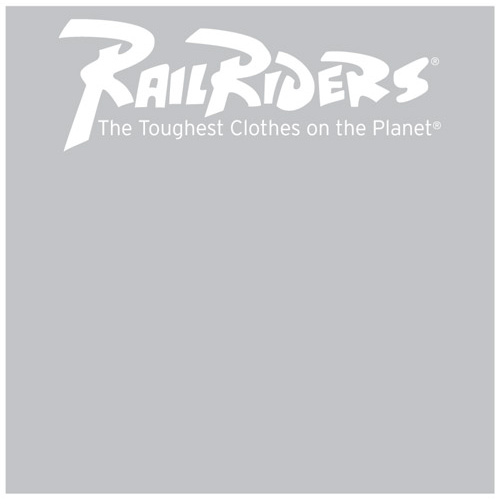
Wildlife photographer Carol Polich is as patient and observant as the big-game animals she stalks with her watchful eye behind the Canon. After years of experience in the African bush, she possesses a sixth sense for capturing the dramatic moment -- two courting giraffes literally necking, frisky zebras in high-kicking play, and orgiastic lions engaged in non-stop sex. The award-winning photographer from Bozeman, Montana, regularly makes extended photo pilgrimages to game parks in southern Africa where her day is often spent at the local watering hole. Her celebrated work appears on greeting cards, in calendars and coffee-table photo books. One of her scenic images-- the Namib sand dunes--won the grand prize in the 1996 National Geographic Traveler's photo contest. Living only 90 minutes from Yellowstone with her husband Jim, Polich, 60, also loves frequenting the national park where she feels quite at home clicking away amid the bighorn sheep and bison. RailRiders spoke with Carol in April. She had recently traveled to Death Valley just as the spring flowers were in bloom. She took along an Eco-Mesh Shirt, which she says,"was the best travel and work shirt I have ever worn, because the material is so unique and soft to the touch, and I never overheated."
Q: I read an article in a travel magazine that said in 1997 you once spent four months and 19,000 miles driving through Africa.
Carol Polich: I've traveled a ton - in southern Africa. But you have to understand, it's like camping in our national parks and actually it's probably more safe because the campsites are fenced in. I always pitch a tent, I'm by myself. I've met so many people over there that I've been adopted into several families along my travels. You're in campgrounds, but here in the west I'm absolutely by myself on Bureau of Land Management land and off in the boonies quite a bit. But when it comes to the animals and two-legged critters, nothing's going to get at you.
Q: Had you had any dangerous encounters camping near animals?
CP: Yeah, in Zimbabwe at Mono Pools. Everyone had been telling me that it was pretty wild to go up there. I was guiding a woman. It's a park where you're allowed to get out and walk, but it's not really wise to be walking by yourself. We had an elephant that came in our camp one night because there are no fences. You're told not to bring any citrus fruit in because elephants can smell IT. We had hyenas come through the camp and I had told my client, Becky, `Don't leave anything.' She left out her dirty socks and I picked them up and said, `Not even your dirty socks, because they'll eat anything.' The restroom was about thirty meters away, an easy walk. I thought, you know what, with the hyenas, I'm going to drive to the restroom! Well, I turned on the engine, the lights came on, and right there coming to our site, ivory tusks and all, was a big elephant. I always pitch a couple of tents - one for myself, and one for whomever. The car was parked near her tent and I just whispered, `Becky, whatever you do, just stay right where you're at.' She said, `What's out there?' I said, `You don't want to know, just don't move.' One step from the elephant and he would have crushed her tent. A few minutes later he then walked over toward my tent and was probably about twenty meters away. I could hear all this cracking and what not. I thought, ‘Oh no, he's demolishing the tent.' But he was actually going under a low-hanging branch. An hour actually passed and I thought, ‘I can't sleep in the car; I'm the guide. I slipped into my tent and woke up at 1:00 a.m. and I heard this pulling of grass and I thought there's only one thing it could be and that would be a hippo because we were right next to the Zambezi River where the hippos come out at night. In a hoarse whisper, I yelled over to Becky to see if she was awake experiencing this. And she was, because she saw the shadow of the hippo. You don't want to encounter hippos at all because they're pretty dangerous. Several months after I left that park, I got an email message back home on how one elephant had come in and actually demolished a tent. Luckily, no one was in it. He also stepped on a car while getting the pods off of a tree.
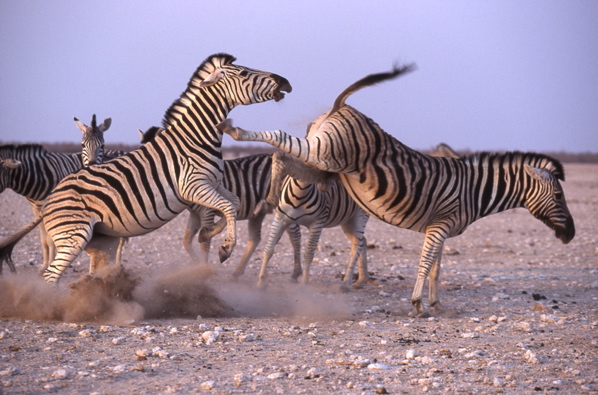
Q: Don't more people die from hippo attacks than anything else in that area?
CP: Yeah, but cape buffaloes are just as dangerous. As a matter of fact, about a year or two years before we got there, a bride and groom from South Africa had gone up there on honeymoon and he was out fishing and she was walking in the grasses. They saw an elephant and they were backing off with the elephant still a ways off. She backed right into a cape buffalo. He trampled her to death.
Q: Any other close encounters with elephants?
CP: I've been charged by elephants when I've been in my vehicle, but I've learned that a lot of times it's a mock charge. Once when I was in a park in South Africa, I suddenly got myself surrounded by a small herd. I was so engrossed in taking pictures and, boy, they were just coming out of the bushes and one young bull was trumpeting and coming up the road. I started to back up my car, but I thought, the heck with this, the more you back up, the more they come. I decided to call his bluff and sure enough, he came charging right by me, ears flapping, trumpeting. Now you start to learn which parks are a little more dangerous, like the Kruger National Park in South Africa where elephants might be a little bit more dangerous because they haven't been culled for management purposes. They're thinking about re-culling again since the population has exploded. Also, people are starting to break rules left and right; they get out of their vehicles. I've reported several people or have yelled at them to get back in their vehicle. And if you get between a cow and a calf, it's never safe; she'll come right at you. Tusks have been absolutely been put through vehicles and then rolled. Another little private game reserve that I was invited to - White Elephant in South Africa – has a wild herd of elephants. The ranger was taking me around where we were seeing the elephants and I kept saying, `Can you hold on? Can you hold on?' And she says, `No way! These elephants have been known to overturn vehicles.' But generally speaking, I know which parks I want to go and get photos of elephants, like in Addo Elephant Park in South Africa where they come within feet of vehicles. The elephants there are relatively non-aggressive. That's not to say they won't mock-charge you, especially if you're parked near the water hole. I've been so close I can reach out - I'm using wide-angle lenses at that point - and they pass right by you.
Q: What kind of vehicle do you normally drive?
CP: Well, I'm in a little low-budget Toyota Tazz. It's not a 4x4, big SUV because of the money crunch. It's good because you can get in and out of spaces, but if the road is low and there's a high sand berm, then you're lower to the grasses and that can be a problem. The 4x4's are about $120 PER day and for me that's way out of my budget, whereas I'm paying between $20 and $25 a day for a little Toyota Tazz; I can use most all the national park roads though I know not to go on a 4x4 road with that vehicle.
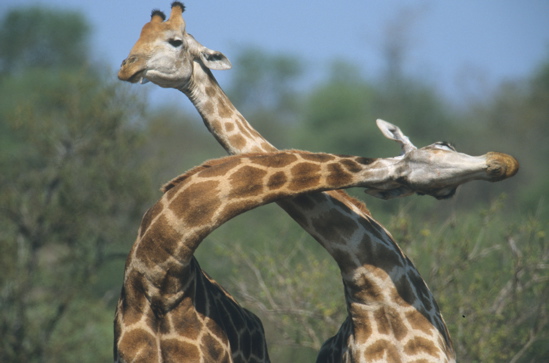
Q: How many times have you traveled to Africa to photograph?
CP: Fourteen times to the continent. The first time was in `86 when I visited Kenya. I have also gone on a camel safari in Kenya in 2006. Other visits have been to Morocco in 1999 and Madagascar in 1998 while I was in South Africa. During my South African visits, I've traveled to Namibia, Botswana, and Zimbabwe.
Q: What other animals at the watering holes do you like to photograph?
CP: Well, when it comes to predators I've had lions right at my front bumper. Lions, especially if they're laying there, are pretty docile. When they're mating, they're a little more aggressive and then I start timing them because every twenty minutes they'll mate.
Q: Every twenty minutes?
CP: Yeah. And this goes on for three to four days.
Q: The same two or different ones?
CP: Pretty much the same two, but I have seen interactions where another female will come by and he will also oblige her. A female lion might be checking him out as well as if he is going to be the pride male, and then he will want to be able to mate with whomever will take him.
Q: Sounds like Lions Gone Wild.
CP: Well, I tell you, as a nature photographer, you become sort of an amateur naturalist. So you have to pick up on the different behavior. Several years ago, I came across three different mating groups. I noticed the approach and obliging and I thought, `Whoa, she's at the end of her estrus cycle and they're not going to do it anymore, and then another female came barging in and he gladly mounted her. Whereas with another group, I saw a female approach an already mating male which snarled at the new female, adding a roar that shook my insides (literally), and wouldn't have anything to do with her. She was submissive and didn't approach any closer. He could possibly kill her.
Q: Why?
CP: He will kill her if she's from a different pride. It has to do with all their social behaviors. As a matter of fact, there was one lioness in the Kruger National Park in South Africa that the rangers had to put down because a lion had come in and broken her spine.
Q: How about cheetahs? Aren't they difficult to locate?
CP: When it comes to cheetahs and leopards, they're not as easy to photograph. The great cheetah shots I've gotten have been at a friend's cheetah reserve. I've found them on a kill and if too many people or other predators come around, they flee; they're real skittish that way. I've also come across three or four youngsters who were starving; something must have happened to their mother because they were barking-- a high-pitched, almost like a bird call sound-- and seemed extremely upset. About a month later when I returned to that park, they had died off because they couldn't hunt for themselves. I've also seen a group of five young cheetahs with the mother hunt and take down an Oryx or Gemsbok, which is highly unusual. Leopards are elusive. I've gotten a few good leopard shots. It seems like the last three times that I've been to Southern Africa, I have rarely seen them.
Q: In these game parks, do you ever come across any poachers?
CP: I haven't personally, but you see the rangers patrolling in places like Kruger National Park in South Africa. In the 1990's, a lot of people were fleeing from Mozambique when there was a civil war. They like to build campfires, thinking that they're going to keep the lions away. But lot of them lost their life to the predators. I'm not sure how bad it is now. But in another reserve called Mkuze in South Africa, which is in the Natal Parks Game Reserve, which would be like our state parks versus national parks, they had actually closed one of the areas because people were getting into cars and there's a lot of thievery and they had some problems with poaching.
Q: For someone who has never been to an African game park, how would you consider the risk while planning an adventure travel vacation?
CP: You know, when I first went over there, it was in 1986 and it was to Kenya on a tour. I got hooked. I've always been interested not only in travel, but in wildlife and animal behavior, even when I was growing up in New Hampshire. What I would recommend to people is go on a tour to begin with until you get a feel for the animals, or you need to go with somebody else. I've been charged by elephants so many times that when I see an elephant herd or one elephant and cars have stopped, I make sure I am not even near those cars and that I have an escape route by turning around and getting the heck out of there because a lot of people who are driving on their own do not understand what harassing type of action they're doing with that animal. In the last eight to ten years, it is getting more and more out of hand. People are getting out of their vehicles to photograph. You're not allowed out of your vehicle; you're not even allowed to sit on the window sill of your vehicle. In Etosha National Park in Namibia, I have seen a whole tour bus of Dutch people out at a water hole building a fire to have breakfast. I was so ticked off because I went to that water hole to photograph and, of course, nothing's going to come. One of the reasons why I often go alone is because I can get around on my own. If I were to go to Kenya, I would be more concerned about the safety with the two-legged kind, of being robbed.
Q: Have you ever been robbed in Africa?
CP: Yes, I was robbed twice in 2004. In Namibia, I had spent time shooting at a ghost town. I then went to Luderitz, which is right on the coast, and I hadn't been there for over fourteen years. My stomach just knotted up when I saw all the loitering, but I needed to get some groceries. I was camped about an hour down the road at a campsite. I tried doing the shopping quickly, but there are all sorts of little things that happened that don't usually happen, like a little boy came up begging for bread in the store. When I got into the car, I noticed the passenger side was unlocked - I thought, geez, that's unusual - I thought I'd locked everything up. Then I raced over to the post office to tap into the Internet, and when I get back to the car, I realized that all my five weeks of exposed film and non-exposed film that was on the floor of the passenger side was missing and my heart started to sink. I then looked under all my sleeping bag stuff and my bag with a couple of cameras and some lenses was gone. I sat there and a black lady walked by and I said, `Look, I've just been robbed. Should I report this?' She said, `Absolutely!' So I raced to the police station and then I had to deal with the police who didn't have any time for a white, foreign woman - to be blunt. And so by the time they got to me, which was an hour later, a policeman went back to the grocery store with me and I was getting nowhere with him and a white guy was getting out of his car and I quickly went up to him and I said, `Can you help me?' I said, `I've been robbed.' He said, `You've been robbed?' He had grown up there and he owned the fanciest hotel in the town. He helped with the police situation and he put me up for three nights. I paid the minimum and I said, `Yeah, let's take this to court. They're making things miserable for me. I'm going to try and make it miserable for them.' They actually caught `two of the thugs'. But I think everyone was in on it: the policemen, the kids, everyone. I didn't expect to get anything back. I wanted to throttle one of the suspects, who wasn't any bigger than me, but he wouldn't talk. I said, `I want my film back! At least my film!' And then in Pretoria, six weeks later, while visiting friends I didn't put the car in the back, because we got so busy talking thieves slashed a tire and broke windows. Everything was gone - my tripod, my wallet, my binoculars, my vest, and that was foolish of me. I had two big lenses in the trunk which saved them. Normally, they would just roll the car down the hill, start it up and take the whole vehicle, so I guess I was lucky there.
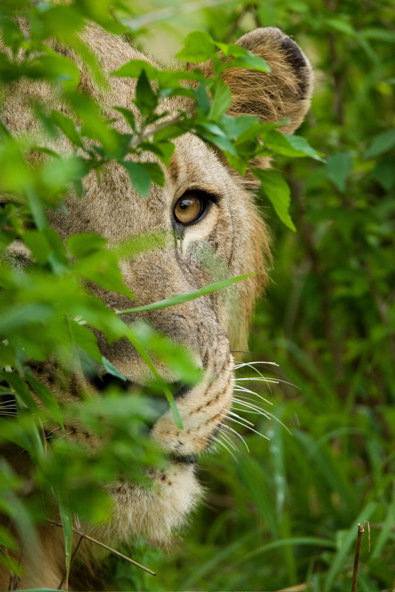
Q: I understand that South Africa is a very dangerous place now.
CP: The danger has increased phenomenally. This non-apartheid era has been worse than apartheid. I've been warned so many times, `Don't stop and picnic alongside the road if there are bushes because my brother was attacked, or tourists had gone off to some of the historical sites and were attacked and shot. So I'm always looking behind my back.
Q: Aren't you playing with fire traveling alone like you do?
CP: I want to get the shots and I want to photograph. I guess it's a matter of getting from point A to B. I've learned where the safe campsites are and those are regular resort campsites before you get to the national parks, and hopefully if I get a flat tire, which I usually do, it's in the park and not on the highway. You can say `playing with fire', but as much as I've traveled on my own, are we going to lock and chain ourselves up? I can't see that. I'm too independent. As a woman on her own, you've got to be wary anyway. You've got to be careful. Don't go off camping near the fence line; be sure you're near the security gate or something.
Q: Let's talk about something a little more rosy. What are some of your favorite places that you photographed?
CP: Etosha National Park in Namibia, because it's wide open. I like Addo Elephant Park in South Africa because you can be close to the elephants. There's other game there as well, but the elephants are probably the big attraction. Kruger National Park in South Africa has also been a favorite.
Q: Let me switch hemispheres to North America.
CP: my first passion is Africa and my second passion is actually Utah. I love going down there and photographing for scenics. When it comes to wildlife, it'd be Yellowstone. I only live an hour and a half away from it.
Q: Have you had any encounters with grizzly bears in Yellowstone?
CP: Well, actually, my first encounter was only about three years ago up in Glacier National Park in Montana. I had my wide-angle lenses on. I was on the boardwalk at the Going to the Sun highway visitors' area. It was early in the morning. I was concentrating on scenics, and a grizzly crossed over the boardwalk and went into some cow parsnips. I'm looking at him, like holy moly! I had an 80-400 lens in my vest pocket. I pulled that out and I started to photograph him. He eventually ambled off. And then just this last summer in Yellowstone, there was one walking right alongside the road. There was a huge traffic jam on the other side of the road. I was the first one on my side of the road. I tried shooting him right through my front window, but I couldn't get a focus. He passed right next to my passenger side. So I quickly did a turnaround with my car, got into the line of traffic, got ahead of him, and actually got into a couple of pullovers, looking for areas where he might come out of the woods because he was going in and out of the woods right alongside the road. Rather foolishly, I got out of the car and shot with a big lens and then a smaller lens and did this twice. I couldn't believe how tolerant he was. I said something to somebody whom I knew who worked in the campgrounds, and he said, `Yeah, but you know what, he was really chomping his teeth, which is a sign of aggression.'
Q: Baring his teeth or chomping?
CP: Chomping. Clattering them. And there was one other time several years ago when one charged and there must have been a hundred photographers and people out in the whole line of traffic ,and this thing came from clear across the valley, probably three or four hundred meters away. I laughed at the mayhem one griz could cause as I raced back to my car about 25 yards away on the road. I thought, one animal is making all these people scatter. He crossed between the cars, and up into the trees and one guy was trying to get into someone else's car but they locked it and wouldn't let him in! But thank goodness, I have never been attacked. But I'll quite frankly say that I do not hike in the back country in Yellowstone by myself. I'm pretty nervous about the grizzlies. And when it comes to Glacier, I have been a little bit on some of these paths, singing and doing what not, because I am alone and really shouldn't be. So when it comes to danger, because we are allowed out of our vehicles in our parks, yes, you should be with somebody or have a very loud voice and even then, that might not help.
Q: Switching locales, you were recently in Death Valley where there are no grizzlies!
CP: Yeah. Lizards and snakes --and I'm into shooting those.
Q: How many times have you been to Death Valley?
CP: Oh, gosh! Eight, nine times. Five years ago I had a calendar out on Death Valley. I've got pictures on postcards from Death Valley.
Q: Your RailRiders clothing hold up well in Death Valley?
CP: I could feel there's a coolness, and I can compare it to other types of outdoorsy shirts. And this material is so much lighter in weight and breathable with the mesh panels. I have tried all sorts of other tops from other companies, but I just found them always to be hot. If it was a windy, cool day --great. But being in the desert in the heat, no way.
Q: What kind cameras do you use?
CP: Since 2000, I'm on Canon and Sigma lenses.
Q: All digital?
CP: I still have a film camera, but boy, these next 3 months in Africa I am definitely going digital, which is a bit, I think, unfortunate.
Q: Why?
CP: Well, I think it's so time consuming to edit your digital work. It's taken the fun out of being a photographer.
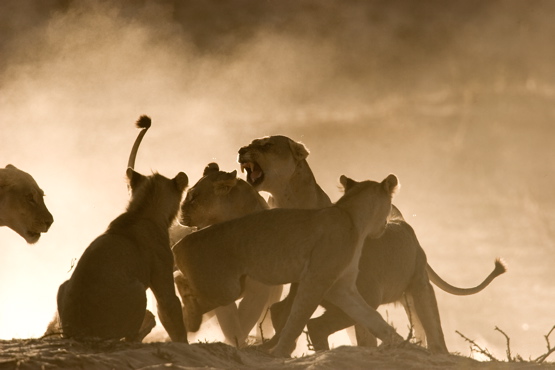
Q: So rather than saving time, digital actually eats up time?
CP: Very much so on the computer. I'm spending hours and hours. It's very easy to get carried away and I have to keep reminding myself: to be selective and to cut down on the editing time. Yet it's a great teaching tool. You can see your work; you can edit it. And for a creative mind, you have to learn technology.
Q: You would normally shoot how many rolls if you went on a photo assignment in Africa?
CP: When I've been on two six-month trips, I took four hundred rolls of film each time. On a three-month trip I would take about two hundred rolls. Last time, because I did have a digital camera with me, and a couple of film cameras, I only went through forty rolls of film. Now, I'm very selective if I'm shooting film.
Q: What's the longest lens that you ever shoot with?
CP: I have a 500 F4 Canon lens. Originally, I had a Sigma and then went over to Canon.
Q: Do you need a tripod with that?
CP: It has an image stabilizer, so I often will hand shoot and get the shot. You have to know how to hold it, and I realize that a lot of people don't know how to hold a camera and lens. ( But a tripod is good.) I have a pistol grip, which is really maxing out a 500 lens with a 1.4 teleconverter, but it works for me and in Yellowstone if the elk and the bison are there and you know you're going to spend quite a while there, then yes, I'll pull out the tripod for the shoot. Now if a coyote is jumping and moving and doing this and that, or the bison are running, and I can get out of the vehicle, I quickly grab that image stabilizing 500 lens and I'm hand holding with the digital cameras like the Canon 40D. I also have a small bean bag for the window. I don't use a mount. Instead, I used a Kirk bean bag, which is great. You can throw it up on the window, you can tip your whole camera equipment forward, you can pan with it and still be steady. It's better than a sand bag because it got two little feet. One of the best things to fill the bag is with rice.
Q: Any closing comments, Carol?
CP: As a nature photographer since the early `90s, my whole world has opened up. I've been exposed to the inter-connectivity of our wildlife, such as coyotes versus jackals; bison versus wildebeests. They serve the same niche. I also relate to the simplicity of wildlife behavior and can see how human behavior has gone awry. I see the role of the male versus the female in nature and I see how that has gone awry in our own world. Also, people have said to me, `Oh, you've been to Death Valley eight times. I mean, what's new?' I think you go back to the same places because they won't be the same the second, third, fifth time around. The forces of Mother Nature are constantly changing.







